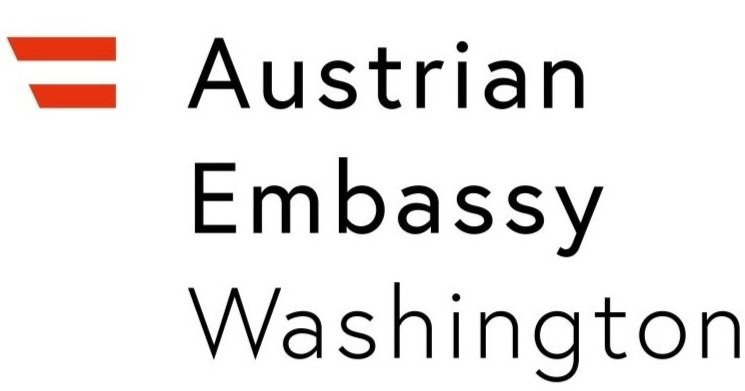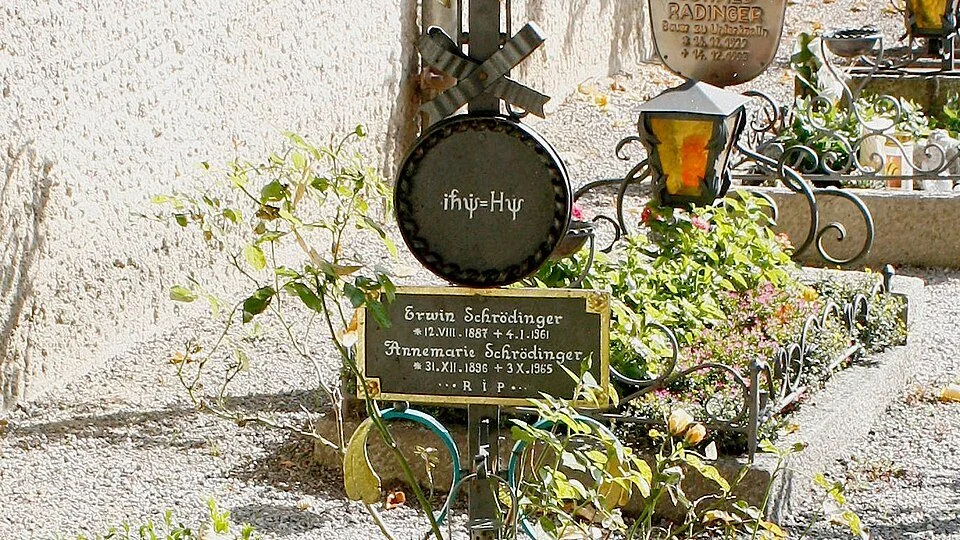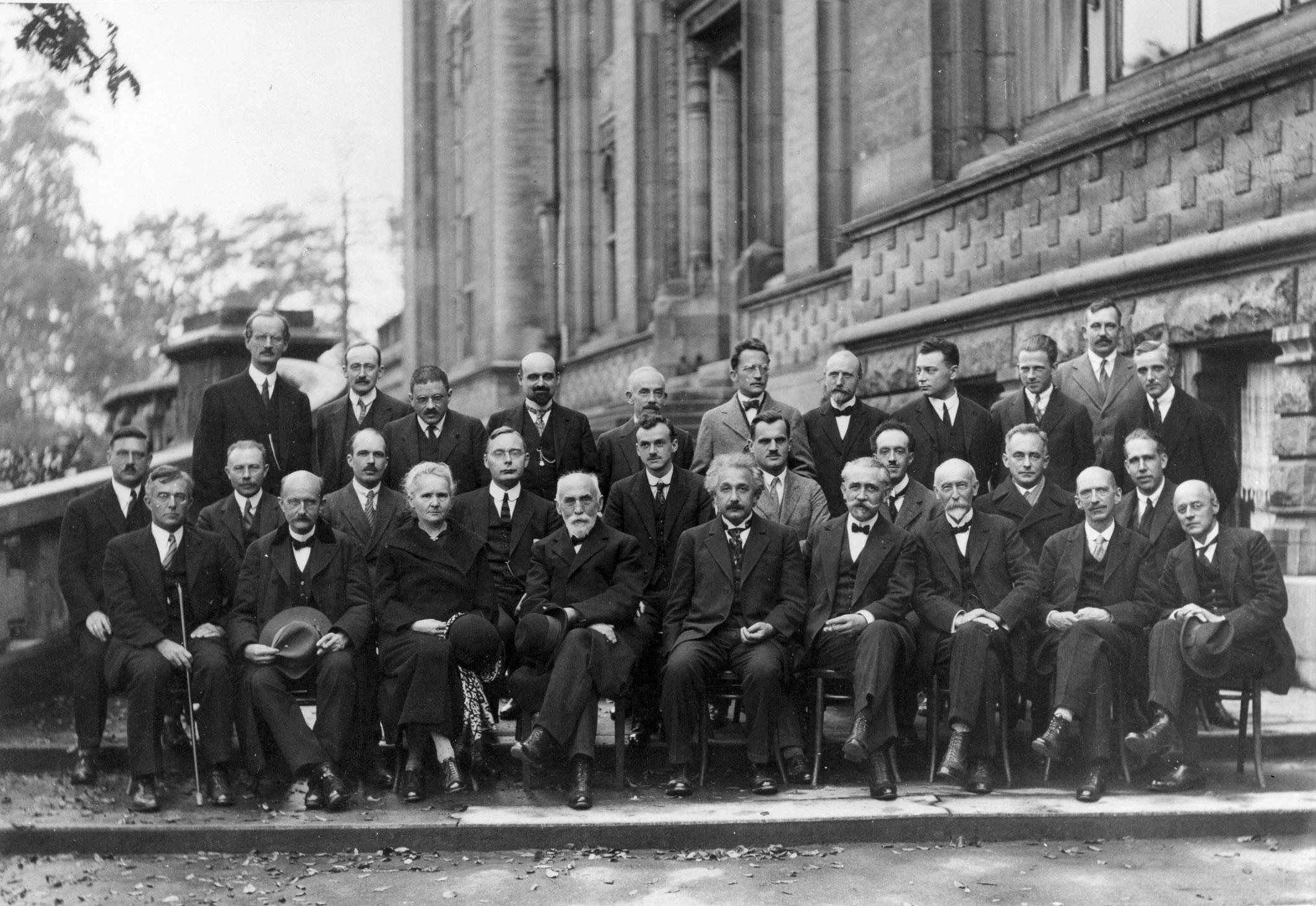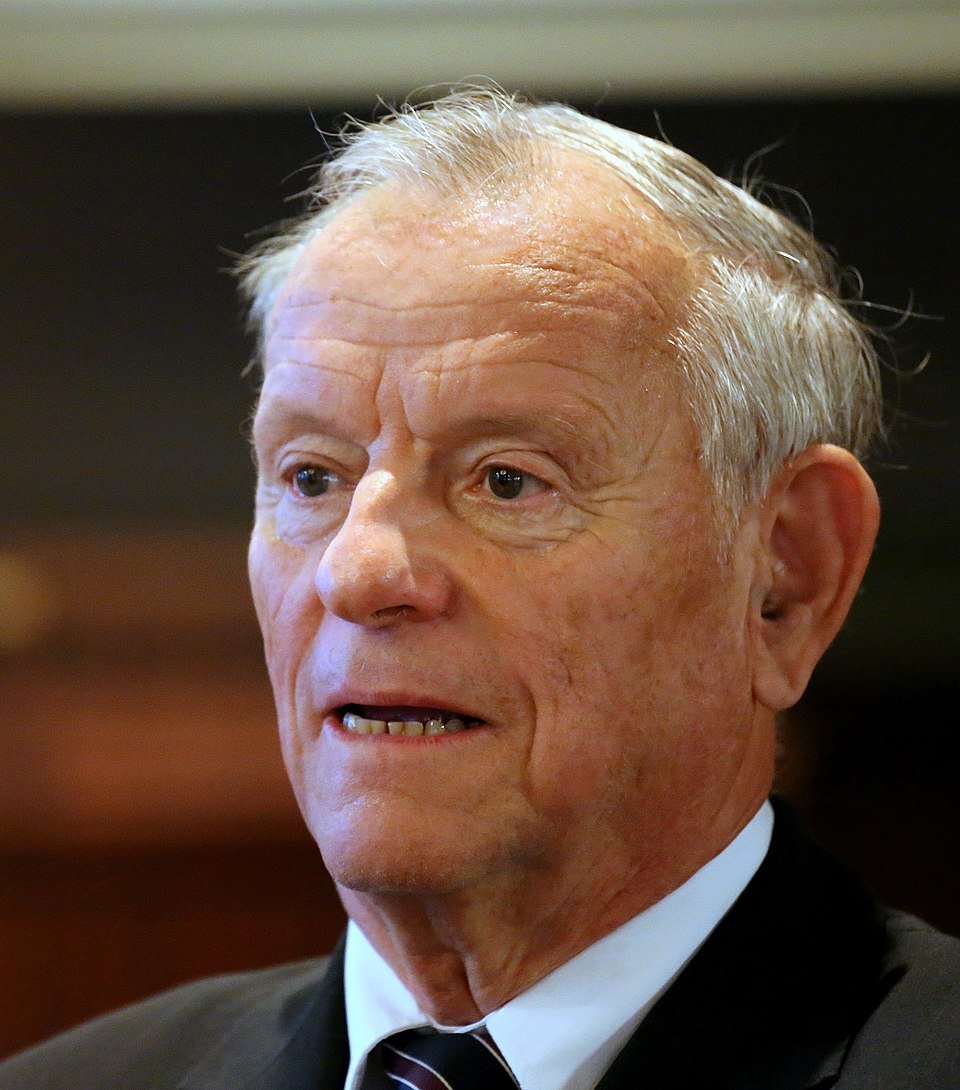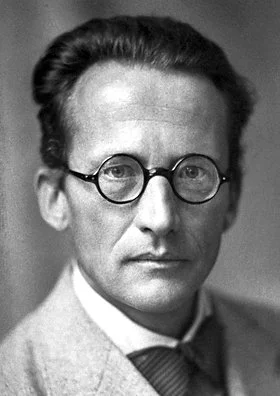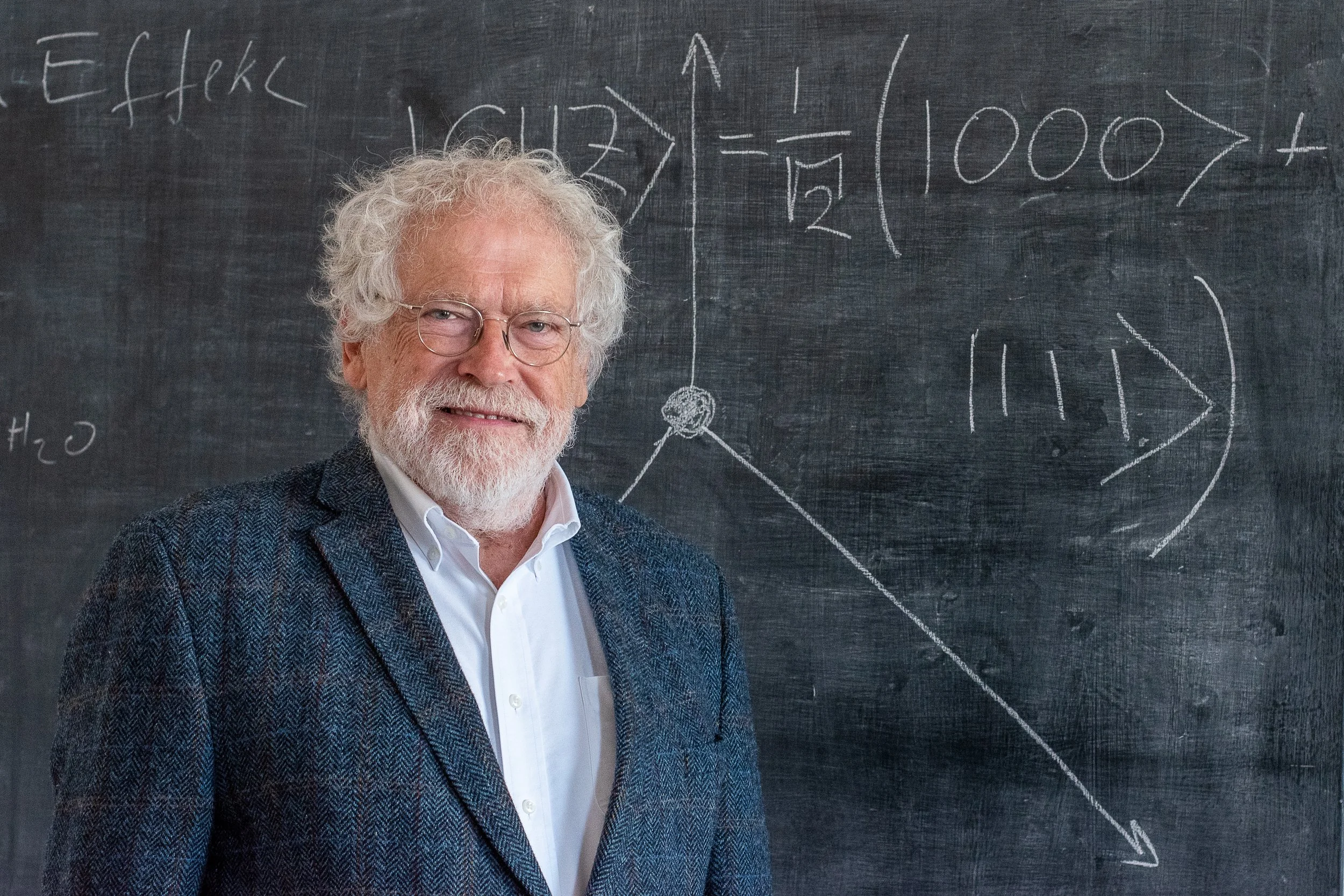Austria’s Century of Quantum Research
By Alois Pumhösel
A look into a quantum computer.
Photo: University of Innsbruck, C. Lackner
Measured against its size, the country in the heart of Europe has made a disproportionately large contribution to the development of quantum science. An astonishing number of Nobel Prize winners in this field also come from Austria.
There is a curious grave in the cemetery of the small village of Alpbach deep in the Tyrolean mountains. The cross on it bears a plaque on which a mathematical formula is depicted in golden letters. It comes from the scientist who was buried here in 1961: Erwin Schrödinger. The inscription shows his most important achievement: an equation that describes the wave nature of electrons. It is an essential foundation of modern quantum mechanics and the basis for understanding phenomena such as superposition of states or particle entanglement.
The Grave of Erwin Schrödinger in Alpbach, Tirol.
Photo: Wikimedia Commons, Karl Gruber, MikeRun
Licensed under the Creative Commons Attribution-Share Alike 3.0 Unported license.
Schrödinger established his most important equation in Zurich in 1926. He had been appointed to the Chair of Theoretical Physics there, which Albert Einstein had already held a few years earlier. Einstein used gravity and the space-time continuum to explain the large structures in the universe. When his theories were applied to the microstructures of matter, contradictions arose that called for new theories - one of which Schrödinger provided with his equation. It not only made him the co-founder of a new physical world view that could view particles as waves, but also placed his home country of Austria irrevocably on the map of quantum science - even if research in the country would not build on this in a more systematic way until decades later.
Today, Austria has a diverse research ecosystem of university and non-university institutions working in this field. Particular strengths lie in quantum optics, in the investigation of the foundations of space, time and gravity or in the theoretical foundations of quantum computers. From Schrödinger, who received the Nobel Prize in Physics in 1933, to Ferenc Krausz, the winner of the prize in 2023, there are a total of five Nobel Prize winners of Austrian origin who can be attributed to the quantum sciences. Over the course of a century, this relatively small country has made significant contributions and has established an extraordinary scientific legacy in the fundamental research field of physics. Numerous start-ups and university spin-offs are also benefiting from this legacy today.
Radioactivity and Cosmic Radiation
Even before Schrödinger's breakthrough, Austria was no stranger to modern physics. The Vienna-born Lise Meitner conducted research into radioactive isotopes together with Otto Hahn in Berlin, which would later lead to the discovery of nuclear fission. The Institute for Radium Research at the Imperial Academy of Sciences was founded in Vienna as early as 1910, while the Habsburg monarchy was still in power. Thanks to the innovative experimental research and the radium stored on site and delivered from Bohemia, it became the center of an international scientific community. Victor Franz Hess was also active here, conducting experiments with high-flying balloons from 1910. He wanted to investigate electrical phenomena in the atmosphere, but instead discovered the high-energy stream of particles known today as cosmic radiation. Later, in the 1930s, Hess would shape research into radioactive radiation in Innsbruck.
In the 1920s, the foundations of quantum mechanics were established at a remarkably rapid pace. In addition to Schrödinger, Werner Heisenberg, Paul Dirac and other mathematicians and physicists made decisive contributions. One of them was the Vienna-born Wolfgang Pauli. In 1925, when he was just 25 years old, he formulated his exclusion principle, a law that complemented Schrödinger's equations and was to have a huge impact on quantum mechanics. He recognized that electrons in an atom could not be the same in all four of their quantum-theoretical state variables - known as quantum numbers. In its later development and generalization, this Pauli principle has shaped our fundamental understanding of the structure of matter to this day.
Twenty-nine leading figures in Physics and Chemistry met for the fifth Solvay Conference, from October 24-29, 1927. The subject was “Electrons and Photons” and the world's most notable physicists met to discuss the newly formulated quantum theory. Among them Albert Einstein, Niels Bohr, Marie Curie, Werner Heisenberg, Max Born, Max Planck, Erwin Schrödinger, Wolfgang Pauli and others.
Photo: Benjamin Couprie, Institut International de Physique de Solvay/ Public Domain
In the Shadow of National Socialism
The Nazi seizure of power interrupted the flourishing quantum physics research in Austria and many other parts of Europe. An unprecedented brain ensued, primarily to the USA. Schrödinger was still a lecturer at the University of Graz in Austria at the end of the 1930s. After the "Anschluss", the incorporation of Austria into the National Socialist German Reich, in 1938 and his subsequent dismissal, he went to Ireland after a stopover at the University of Ghent in Belgium, where he became head of the Institute for Theoretical Physics at the newly created Dublin Institute for Advanced Studies (DIAS). Pauli, who had Jewish ancestors, accepted a position at Princeton University in 1940, where Albert Einstein was working at the same time. He was awarded the Nobel Prize in Physics in 1945 and returned to his former place of work at ETH Zurich the following year.
Before the outbreak of the Second World War, thousands of minors from Jewish families were rescued by the Kindertransporte, a program which evacuated children from countries threatened by the Nazis. One of these children was Walter Kohn from Vienna. He was also to make significant breakthroughs in the field of quantum science. He was responsible for the so-called density functional theory, which was to revolutionize materials science by opening up new possibilities for simulation. In his research in the 1960s, Kohn recognized that the quantum mechanical ground state of a molecule or solid can be clearly determined by its electron density. Based on this, many other properties could be derived and electron interactions determined. This achievement, for which Kohn was honored with the Nobel Prize in Chemistry in 1998, enabled analyses that were not feasible using the Schrödinger equation. Kohn worked at several US universities over the course of his long career, but he also remained connected to his old native city of Vienna through numerous visits.
Helmut Rauch in 2013
Photo: Tamas Thaler
The 1960s also saw new momentum in Austrian quantum research. The rebuilding of the country was in full swing and the state was increasingly investing in the sciences. In keeping with the spirit of the times, nuclear physics was a particular focus. The USA's Atoms for Peace program also helped to expand civilian nuclear research in Austria. In 1958, the Atominstitut had already been founded in Vienna, which later became part of the Vienna University of Technology. From the 1970s, Helmut Rauch was Professor of Experimental Nuclear Physics there - a scientist who was to shape quantum science in Austria for decades: as a researcher, institute director and in the form of science policy commitments, for example as President of the Austrian Science Fund (FWF).
Manipulation of Matter Waves
In his early days at the Atominstitut, Rauch developed neutron interferometry, which enabled more precise research into quantum phenomena and became the basis for a large number of experiments and applications. Using a silicon crystal, Rauch and his colleagues succeeded for the first time in splitting, manipulating and recombining matter waves over a large distance. This provided experimental proof that - as predicted by quantum mechanics - particles with mass can also behave like waves. Rauch was denied a Nobel Prize. In Vienna, however, he established his own research tradition with his quantum optics, which works with matter waves. It was to play a significant role in the success of Austrian quantum physics in the decades that followed.
As early as 1971, a scientist who was to symbolize Austria's rise as a "quantum nation" like no other received his doctorate under Rauch: Anton Zeilinger. While he was still working with Rauch on the fundamentals of neutron interferometry, Zeilinger also became interested in a special quantum phenomenon - entanglement, in which particles always showed the same (or, depending on the type of entanglement, complementary) measurement result thanks to their special connections. Albert Einstein, who discussed the topic in a publication in 1935, could not believe that this "spooky action at a distance" could work without hidden variables. Zeilinger built on initial theoretical and experimental evidence from the 1960s onwards and, together with colleagues, proposed a particularly efficient experiment in 1989: measurements on three entangled particles were to definitively confirm the exclusion of hidden variables. Ten years later, this so-called GHZ experiment was realized.
During these ten years, the researchers developed the necessary technologies, such as a new type of source for entangled light particles. It turned out that instruments of this kind could also be used for other research approaches. They enabled Zeilinger's now famous work on teleportation, in which quantum states could be transferred from one place to another via particle entanglement. Over the years, the technologies involved became increasingly sophisticated and the transmission distances greater. At the same time, experiments in quantum cryptography based on quantum teleportation began. The first image to be sent in an absolutely secure encrypted form showed Austria's most famous archaeological find: the 30,000-year-old figure of Venus of Willendorf. Today, a satellite network for global quantum-encrypted communication is being built. Zeilinger was honored with the 2022 Nobel Prize in Physics for his pioneering work in quantum communication.
A New Type of Quantum Computer
In retrospect, a pivotal point in the history of Austrian quantum research was the Tyrolean capital of Innsbruck in the 1990s - not far from Schrödinger's final resting place in Alpbach. It was not only Zeilinger, as Professor of Experimental Physics, who researched GHZ technologies there. In 1994, Tyrolean Peter Zoller, who had been working on a theory on so-called ion traps in the USA, also returned to his home country. Zoller showed how ions held in electric fields and manipulated with lasers could become a key element for quantum computers. One of the first experimental realizations was then achieved by experimental physicist Rainer Blatt in Innsbruck. Another breakthrough followed in 2004, when the quantum information of an atom could be transferred to another atom in a completely controlled manner thanks to this development. Today, Blatt works with experimental quantum computers that use dozens of quantum bits based on ion traps. Ion traps have become one of the most important realization variants of quantum computers and have become a research focus in Innsbruck with worldwide appeal.
While research in Innsbruck laid the foundations for quantum computers, the focus in Vienna was on quantum optics, among other things. In 2001, the team led by the Hungarian-Austrian physicist Ferenc Krausz at the Vienna University of Technology was busy bombarding neon gas with laser pulses. Electrons in gas atoms were to be briefly thrown off course, leading to the creation of high-energy light quanta. They are of extremely short duration - in the range of attoseconds, i.e. a billionth of a billionth of a second. Krausz and his colleagues succeeded in experimentally demonstrating these atto-light flashes for the first time. This breakthrough, for which Krausz was awarded the Nobel Prize in Physics in 2023, opened up a new view of the world on a quantum scale and made physical measurements possible on an unfathomably high-resolution time scale.
The successes of Austrian quantum researchers from the 1990s onwards also brought movement to the country's research structures. New working groups and institutes were founded or expanded. One milestone was the establishment of the Institute for Quantum Optics and Quantum Information (IQOQI) at the Austrian Academy of Sciences (ÖAW) in Innsbruck and Vienna, which was intended to provide a common framework for the successful research at both locations. Zoller and Zeilinger, both pioneers of the institute, continue to lead their research groups here 20 years later, side by side with excellent physicists of a new generation.
Modern Research Structure
Today, Austria is a country with an astonishingly high density of quantum scientists from all over the world. There are currently around 70 relevant research groups working at the University of Innsbruck, TU Wien, the University of Vienna, Johannes Kepler University Linz, the Austrian Academy of Sciences (ÖAW) and the Institute of Science and Technology Austria (ISTA) in Klosterneuburg. In 2023, they were given a new platform with the Cluster of Excellence Quantum Science Austria (quantA). The cluster, which is supported by the Austrian Science Fund (FWF) and participating institutions, enables large-scale research projects across disciplinary and institutional boundaries. The aim is to deepen national strengths such as fundamental research with ion traps, ultracold quantum gases or entangled light particles, to open up new fields for the future and to expand the understanding of fundamental questions about space, time and gravity.
Alpbach, which would become Schrödinger's final resting place, has become a place of international exchange despite its hidden location in the mountains. Every year, the European Forum Alpbach brings together leading figures from the fields of politics, science and business to exchange ideas with a young audience. This is very much in the spirit of the quantum sciences, where new ideas, unexpected connections and - as it turns out - local traditions can be the secret of success.
Pioneer of Quantum Mechanics
Erwin Schrödinger’s Schrödinger equation created a mathematical foundation on which physics and chemistry are still built today.
Is the cat alive, is it dead or is it some odd way both? Erwin Schrödinger is perhaps better known to the general public not as the founder of quantum mechanics, but rather as the originator of the term "Schrödinger's cat". This is a thought experiment in which the life and death of a cat locked in a box depends on a quantum mechanical process. The physicist wanted to demonstrate the paradoxes caused by the clash between quantum science and classical physics. Schrödinger, born in Vienna in 1887, provided a mathematical basis for many phenomena in the quantum world with the equation named after him.
Portrait of Erwin Schrödinger in 1933
Photo: Nobel Foundation/ Public Domain
The path to this breakthrough was paved by his studies at the University of Vienna and research positions at the universities in Jena, Stuttgart, Breslau and Zurich. However, Schrödinger was dissatisfied with how his equation was later integrated into the systematization of quantum research that still prevails today, the so-called Copenhagen interpretation. The fact that his wave function was supposed to describe a probability distribution contradicted his understanding of physics - the image of the cat in the box bears witness to this.
The rise of the National Socialists had serious consequences for Schrödinger's research career. In 1933, the year he was awarded the Nobel Prize in Physics, he left the University of Berlin, where he had been working since 1927. Back in Austria, he also lost his job after the Anschluss. He found a new home in Dublin and acquired Irish citizenship in addition to his Austrian citizenship in 1948. It was not until 1956 that he returned to the University of Vienna, where he was Professor of Theoretical Physics until his death in 1961. He was buried in the mountain village of Alpbach, which he had known since childhood and repeatedly visited as part of the European Forum Alpbach. For Austria, Erwin Schrödinger became a symbol of scientific excellence and the efficiency of the country's cutting-edge research.
The Child Prodigy of Particle Physics
Wolfgang Pauli discovered essential principles on the structure of matter
Wolfgang Pauli attracted attention at a young age with his brilliant achievements. Born in Vienna in 1900, the son of a journalist and a doctor, he was already studying higher mathematics and Albert Einstein's then-new theory of relativity in secondary school. He obtained his doctorate in physics at the age of just 21 - although, according to sources, he loved nightlife and was often late for 11 o'clock lectures. His article on the theory of relativity in the Encyclopedia of Mathematical Sciences, which he wrote at the age of 20, astonished even established colleagues with his knowledge of the literature and his analytical skills.
Wolfgang Pauli, circa 1945
Photo: ETH Library Zurich, Image Archive
Even in his early career, he was associated with big names: he studied with Werner Heisenberg, worked with Max Born in Göttingen and Niels Bohr in Copenhagen before taking up a professorship in Hamburg. Pauli was considered a perfectionist, but also a sharp and pointed critic. At the same time, he was self-deprecating about his own clumsiness. The "Pauli effect", to which he himself often referred, seemed to cause experiments and laboratory equipment to fail.
His great achievements in quantum mechanics, particularly his Pauli exclusion principle, which solved major theoretical problems in the structure of atoms and later earned him the Nobel Prize in Physics, occurred during his years in Hamburg. In 1928 he was appointed to the ETH Zurich. There, with his Pauli exclusion matrices, he not only provided a mathematical explanation for the phenomenon of electron spin, but also predicted the existence of neutrons in theoretical work. Due to his Jewish descent, he went to the USA in 1940 and conducted research in Princeton, but returned to ETH Zurich in 1946, where he worked until his death in 1958.
A New Overview of the Microcosm
Walter Kohn managed to significantly simplify complex quantum mechanical calculations in a decisive way
Three weeks before the outbreak of the Second World War, Walter Kohn barely managed to leave Vienna - on the last of the Kindertransporte, which brought Jewish children to safety. His father's flourishing postcard publishing company was "Aryanized". His parents and most of his relatives were murdered by the Nazis. Walter Kohn, born in 1923, first came to England, where he was interned as an "enemy alien" and later taken to Canada. After his release in 1942, he studied mathematics and physics in Toronto, but also spent a year in the Canadian army.
Walter Kohn at the 62nd Lindau Nobel Laureate Meeting on July 3, 2012
Photo: (Wikipedia/Author Markus Pössel (User name: Mapos)/ (CC BY-SA 3.0)
A scholarship took Kohn to Harvard University, where he received his doctorate in 1948. Further stages in his career included the Carnegie Institute of Technology in Pittsburgh, Pennsylvania, and the University of California, where he became founding director of the Institute of Theoretical Physics in Santa Barbara in 1979. Early on, Kohn concentrated on improving the ability to calculate complex quantum mechanical systems. His scientific work is among the most cited of all and has had enormous consequences for chemistry, material science and many other disciplines. Wherever the behavior of complex molecules is calculated or simulated, Kohn's findings are used in one way or another.
Kohn retired in 1991 and was awarded the Nobel Prize in Chemistry in 1998. He had an ambivalent relationship with Austria: he had fond memories of the cosmopolitan city of Vienna of his childhood. However, this childhood came to an abrupt end. In his later years, he also received many honors in Austria - from the Austrian Cross of Honor for Science and Art to an honorary doctorate from the Vienna University of Technology. However, given the fate of his family, Kohn, who had held US citizenship since 1957, also refused to be referred to as an "Austrian Nobel Prize winner". He died in 2016 in Santa Barbara, his new home in the USA.
Pioneer of Quantum Communication
Anton Zeilinger's experiments in teleportation and cryptography gave quantum research an applied perspective
"If you are working on something that you find exciting, then do it and pay no attention to what others say," Anton Zeilinger once said. He himself has also adhered to this principle. Zeilinger, born in Upper Austria in 1945, studied physics and mathematics at the University of Vienna. In interviews, he repeatedly emphasizes his doctoral supervisor Helmut Rauch, who created a climate of freedom and allowed him to pursue his own interests without regard to the immediate benefits.
Anton Zeilinger
Photo: Jacqueline Godany
In the 1970s, Zeilinger did not just remain Rauch's assistant. Equipped with a Fulbright scholarship, he went to the Massachusetts Institute of Technology (MIT) in 1977, where he worked with the future Nobel Prize winner Clifford G. Shull. He returned to MIT again and again in the 1980s, where he was also an associate professor of physics there for two years. During these stays, he met Daniel Greenberger and Michael Horne, with whom he later realized the groundbreaking GHZ experiment. In 1990, he was appointed professor at the University of Innsbruck. There he worked on the GHZ experiment and carried out the first experiments on quantum teleportation.
In 1999, he moved to the University of Vienna and in 2004 he became the founding director of the Vienna Institute for Quantum Optics and Quantum Information (IQOQI) of the Austrian Academy of Sciences (ÖAW). While there, he continued to research the technological foundations of quantum cryptography. In 2017, he finally presented the first quantum-encrypted video call via satellite. From 2013 to 2022, he also played a key role in shaping Austria's research policy in his role as President of the Austrian Academy of Sciences.
One of Zeilinger's great achievements is to have given quantum science a perspective of practical application, which was also emphasized when he was awarded the Nobel Prize in Physics in 2022. He became one of the best-known physicists in the world and saw his success and the progress of Austrian quantum research as being rooted in a tradition whose origins he traced back to the philosophy of the Vienna School in the early 20th century. "There is this openness to fundamental questions that is unique to Vienna," he emphasized in this regard.
A Measure of Time for the Quantum World
Ferenc Krausz's attosecond technique provides a new view inside atoms
Ferenc Krausz
Photo: Wikimedia, Max-Planck-Institut für Quantenoptik. User: Thorsten Naeser.
Creative Commons 2.0
The laws of nature do not end at national borders, and research into them should not end there either: Ferenc Krausz emphasized the importance of cross-border research in an interview given upon receiving the 2023 Nobel Prize in Physics: "It's not just about creating new knowledge, but also about connecting people and getting to know foreign cultures. In its own way, science contributes a great deal to a peaceful world." Krausz, who was born in 1962 in Mór in Hungary, which at the time was an Eastern Bloc country behind the Iron Curtain, studied technical physics and electrical engineering in Budapest before joining the Vienna University of Technology in 1988. In his dissertation, which he completed in 1991, he already dealt with the subject area that would ultimately lead him to the Nobel Prize in Physics in 2023 - ultrashort pulse lasers.
Thanks in part to the funding infrastructure in the field of fundamental research, Krausz was then able to massively expand his research efforts in Austria. By 1997, he and his team had already achieved laser pulses in the low femtosecond range. In 2001, they achieved a breakthrough into the attosecond world, which makes measurements at incredibly high resolutions possible. By way of comparison: in an attosecond, light only travels about a millionth of a millimeter.
In 2003, Krausz, who is a dual Hungarian and Austrian citizen, moved to Germany. At the Max Planck Institute in Garching and a number of other institutes, he is working on using the new technology for measurements in the subatomic range, among other things. However, the field of application is much broader and ranges from faster computer technology to medical diagnostics. Krausz's ideal of cross-border and peacemaking research was also put into practice after Russia's attack on Ukraine. In the organization "Science4People", which he founded, he uses his worldwide scientific network to support displaced researchers from Ukraine.
